Light travels at the speed of around 186,000 miles per second. This tremendous speed has enabled us to use light for telecommunication systems with low losses. Engineers are constantly driven to develop faster processing components. Then why would one care about slow light? It turns out photons rarely interact with each other when they travel very fast. Slow light can be very useful to force photons to interact with each other. Multi-photon interactions lie at the heart of nonlinear effects.
Slow light can seem a contradiction, as physicists know that photons always travel at the speed of light. The right way to think about slow light is that it is a model for light interactions with matter. Light is absorbed and emitted at a later time. We perceive light to move slowly when this is viewed over a period of time, for a large scale of atoms. Slow light has various applications from enhanced nonlinear effects, optical buffers for efficiently distributing light, and optical memories to name a few. In the emerging field of quantum photonics, slow light can force interactions between photons to create entangled photons. The article describes slow light created with integrated silicon photonics.
How to create slow light?
Slow light can be created by dispersion engineering. Dispersion refers to the variation of refractive index with wavelength. Since sending information in a medium required a band of frequencies, group velocity is used to measure transmission speed. This is the rate of change of refractive index with wavelength. While dispersion relations are fixed for given compounds, there are ways to engineer this in photonic crystal waveguides.

Photonic crystals with coupled cavities used to create slow light. Light leaks slowly between adjacent cavities. Courtesy of Phys.org
Slow light in photonic chips
Photonic crystals are used to design dispersion relations for light, similar to electronic crystals for electron dispersion relations. The schematic shown below consists of photonic crystal waveguides fabricated using silicon photonics. A series of coupled resonator oscillator waveguides (CROW) are designed for small group velocities.
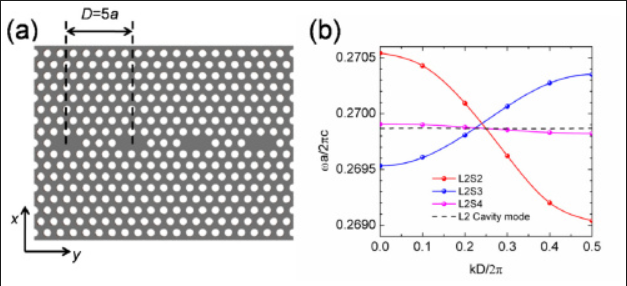
Coupled resonator waveguides. (a) The top view of the photonic chip. Grey holes are optical cavities. (b) Dispersion relation for the guided light. The guided mode has a lower slope (small group velocity). Courtesy of OSA
Each optical cavity confines light to a high degree, which is represented by the grey area in the image. Light is loosely coupled between cavities, which causes light to propagate slowly. This gives rise to a small group velocity.
Applications of slow light
Nonlinear frequency generation:
A typical design for using slow light involves combining fast light silicon components with a slow light optical processing elements in between. The image below uses this design for enhanced third harmonic generation. Infrared light at 1550 nm enters the photonic crystal from the left. In the intermediate photonic crystal region, third harmonic generation (THG) is used to convert infrared light to green light. Since the photonic crystal operates in the slow right region, the output power of the green light is significantly higher.
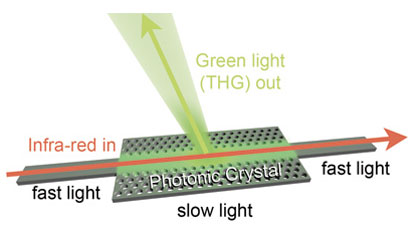
Photonic crystal enhances third harmonic generation to produce green light.
Muti-wavelength processing:
Slow light can be using in conjunction with wavelength division multiplexing (WDM) to create an intermediate non-linear processing element for spectroscopic applications. Moreover, enhanced nonlinear effect can be used to to achieve a spectral resolution of sub-GHz by array waveguide grating, which is well suited for chemical and gas sample analysis.
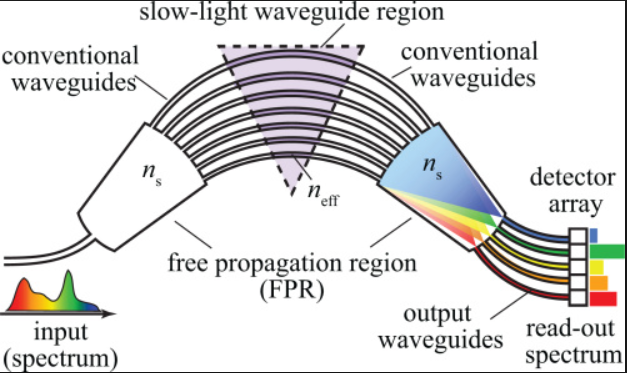
Arrayed waveguide grating spectrometers for higher spectral resolution. Courtesy of OSA.
Photonic interferometers:
Quantum photonics can also add slow light to its toolbox. Quantum effects such as coherence and entanglement can be realized in coupled resonator cavities in a photonic crystal. Nonlinear interactions force the single photons to interact with each other. The image below uses coherence effects in interacting single photons. The interference fringes are detected using Mach-Zehnder interferometers.
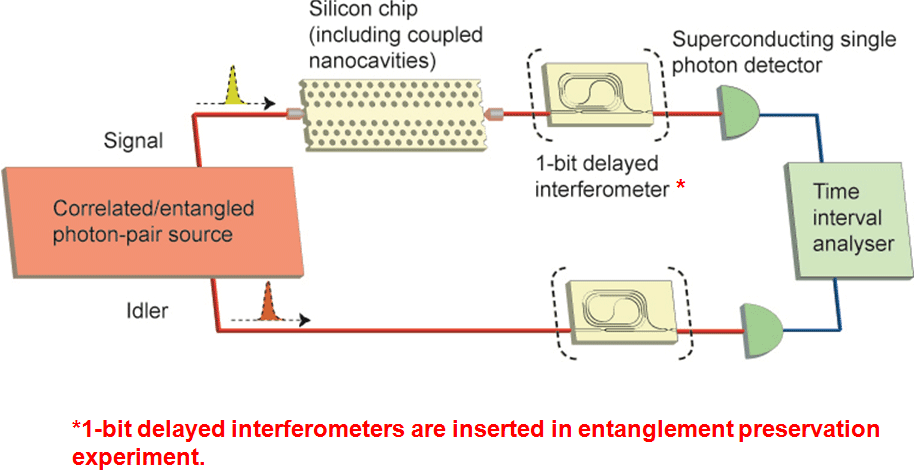
Slow light used to create a quantum inteferometer by modulating light in the top arm. Courtesy of Phys.Org
Since photons travel at different speeds at the top and the bottom arm of the interferometers, the output can exhibit interference fringes that can be measured. This scheme can also insert entangled photons and observe temporal coherence measurements.
Short intense pulse generation:
Dispersion engineering causes light to acquire a higher bandwidth in the frequency domain, and hence a compression of the pulse duration. Moreover, this also increases the intensity of the pulse, while keeping the energy moderate. Applications of using slow light for generating short pulses can open doors for on chip spectroscopy with short pulses.
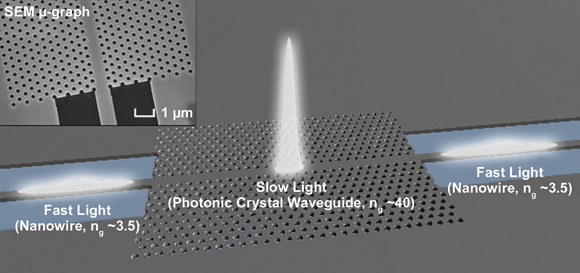
Slow light used to shorten pulse duration and increase intensity for intermediate light processing. Courtesy of Photonics Media
The future for slow light effects remains promising for nonlinear photonics. Tailoring the dispersion relation, while maintaining design in silicon can keep the cost and power consumption low. For using interesting nonlinear effects of light in your designs, check out FindLight’s collection of non-linear crystals.

interesting